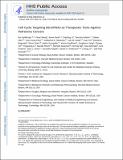Cell-Cycle-Targeting MicroRNAs as Therapeutic Tools against Refractory Cancers
Author(s)
Hydbring, Per; Wang, Yinan; Fassl, Anne; Li, Xiaoting; Matia, Veronica; Otto, Tobias; Choi, Yoon Jong; Sweeney, Katharine E.; Suski, Jan M.; Yin, Hao; Bogorad, Roman; Goel, Shom; Yuzugullu, Haluk; Kauffman, Kevin John; Yang, Jung H; Jin, Chong; Li, Yingxiang; Floris, Davide; Swanson, Richard; Ng, Kimmie; Sicinska, Ewa; Anders, Lars; Zhao, Jean J.; Polyak, Kornelia; Anderson, Daniel Griffith; Li, Cheng; Sicinski, Piotr; ... Show more Show less
DownloadAccepted version (1.359Mb)
Terms of use
Metadata
Show full item recordAbstract
Cyclins and cyclin-dependent kinases (CDKs) are hyperactivated in numerous human tumors. To identify means of interfering with cyclins/CDKs, we performed nine genome-wide screens for human microRNAs (miRNAs) directly regulating cell-cycle proteins. We uncovered a distinct class of miRNAs that target nearly all cyclins/CDKs, which are very effective in inhibiting cancer cell proliferation. By profiling the response of over 120 human cancer cell lines, we derived an expression-based algorithm that can predict the response of tumors to cell-cycle-targeting miRNAs. Using systemic administration of nanoparticle-formulated miRNAs, we inhibited tumor progression in seven mouse xenograft models, including three treatment-refractory patient-derived tumors, without affecting normal tissues. Our results highlight the utility of using cell-cycle-targeting miRNAs for treatment of refractory cancer types. Keywords: cell cycle; cyclins; cyclin-dependent kinases; microRNAs; cancers
Date issued
2017-04Department
Massachusetts Institute of Technology. Department of Chemical Engineering; Massachusetts Institute of Technology. Institute for Medical Engineering & Science; Harvard University--MIT Division of Health Sciences and Technology; Koch Institute for Integrative Cancer Research at MITJournal
Cancer Cell
Publisher
Elsevier BV
Citation
Hydbring, Per et al. "Cell-Cycle-Targeting MicroRNAs as Therapeutic Tools against Refractory Cancers." Cancer Cell 31, 4 (April 2017): 576-590 © 2017 Elsevier Inc
Version: Author's final manuscript
ISSN
1535-6108